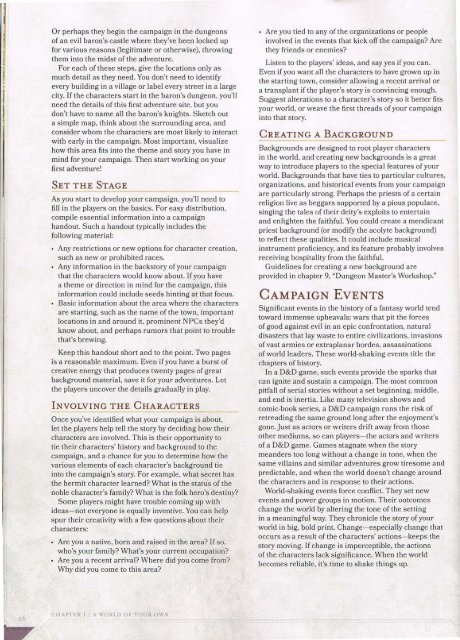Dungeon Master's Guide
Create successful ePaper yourself
Turn your PDF publications into a flip-book with our unique Google optimized e-Paper software.
Or perhaps they begin the campaign in the dungeons<br />
of an evil baron's castle where they've been locked up<br />
for various reasons (legitimate or otherwise), throwing<br />
them into the midst of the adventure.<br />
For each of these steps, give the locations only as<br />
much detail as they need. You don't need to identify<br />
every building in a village or label every street in a large<br />
city. If the characters start in the baron's dungeon, you'll<br />
need the details of this first adventure site, but you<br />
don't have to name all the baron's knights. Sketch out<br />
a simple map, think about the surrounding area, and<br />
consider whom the characters are most likely to interact<br />
with early in the campaign. Most important, visualize<br />
how this area fits into the theme and story you have in<br />
mind for your campaign. Then start working on your<br />
first adventure!<br />
SET THE STAGE<br />
As you start to develop your campaign, you'll need to<br />
fill in the players on the basics. For easy distribution,<br />
compile essential information into a campaign<br />
handout. Such a handout typically includes the<br />
following material:<br />
Any restrictions or new options for character creation,<br />
such as new or prohibited races.<br />
Any information in the backs tory of your campaign<br />
that the characters would know about. If you have<br />
a theme or direction in mind for the campaign, this<br />
information could include seeds hinting at that focus.<br />
• Basic information about the area where the characters<br />
are starting, such as the name of the town, important<br />
locations in and around it, prominent NPCs they'd<br />
know about, and perhaps rumors that point to trouble<br />
that's brewing.<br />
Keep this handout short and to the point. Two pages<br />
is a reasonable maximum. Even if you have a burst of<br />
creative energy that produces twenty pages of great<br />
background material, save it for your adventures. Let<br />
the players uncover the details gradually in play.<br />
INVOLVING THE CHARACTERS<br />
Once you've identified what your campaign is about,<br />
let the players help tell the story by deciding how their<br />
characters are involved. This is their opportunity to<br />
tie their characters' history and background to the<br />
campaign, and a chance for you to determine how the<br />
various elements of each character's background tie<br />
into the campaign's story. For example, what secret has<br />
the hermit character learned? What is the status of the<br />
noble character's family? What is the folk hero's destiny?<br />
Some players might have trouble coming up with<br />
ideas-not everyone is equally inventive. You can help<br />
spur their creativity with a few questions about their<br />
characters:<br />
Are you a native, born and raised in the area? If so,<br />
who's your family? What's your current occupation?<br />
• Are you a recent arrival? Where did you come from?<br />
Why did you come to this area?<br />
Are you tied to any of the organizations or people<br />
involved in the events that kick off the campaign? Are<br />
they friends or enemies?<br />
Listen to the players' ideas, and say yes if you can.<br />
Even if you want all the characters to have grown up in<br />
the starting town, consider allowing a recent arrival or<br />
a transplant if the player's story is convincing enough.<br />
Suggest alterations to a character's story so it better fits<br />
your world, or weave the first threads of your campaign<br />
into that story.<br />
CREATING A BACKGROUND<br />
Backgrounds are designed to root player characters<br />
in the world, and creating new backgrounds is a great<br />
way to introduce players to the special features of your<br />
world. Backgrounds that have ties to particular cultures,<br />
organizations, and historical events from your campaign<br />
are particularly strong. Perhaps the priests of a certain<br />
religion live as beggars supported by a pious populace,<br />
singing the tales of their deity's exploits to entertain<br />
and enlighten the faithful. You could create a mendicant<br />
priest background (or modify the acolyte background)<br />
to reflect these qualities. It could include musical<br />
instrument proficiency, and its feature probably involves<br />
receiving hospitality from the faithful.<br />
<strong>Guide</strong>lines for creating a new background are<br />
provided in chapter 9, "<strong>Dungeon</strong> Master's Workshop."<br />
CAMPAIGN EVENTS<br />
Significant events in the history of a fantasy world tend<br />
toward immense upheavals: wars that pit the forces<br />
of good against evil in an epic confrontation, natural<br />
disasters that lay waste to entire civilizations, invasions<br />
of vast armies or extra planar hordes, assassinations<br />
of world leaders. These world-shaking events title the<br />
chapters of history.<br />
In a D&D game, such events provide the sparks that<br />
can ignite and sustain a campaign. The most common<br />
pitfall of serial stories without a set beginning, mfddle,<br />
and end is inertia. Like many television shows and<br />
comic-book series, a D&D campaign runs the risk of<br />
retreading the same ground long after the enjoyment's<br />
gone. Just as actors or writers drift away from those<br />
other mediums, so can players- the actors and writers<br />
of a D&D game. Games stagnate when the story<br />
meanders too long without a change in tone, when the<br />
same villains and similar adventures grow tiresome and<br />
predictable, and when the world doesn't change around<br />
the characters and in response to their actions.<br />
World-shaking events force conflict. They set new<br />
events and power groups in motion. Their outcomes<br />
change the world by altering the tone of the setting<br />
in a meaningful way. They chronicle the story of your<br />
world in big, bold print. Change- especially change that<br />
occurs as a result of the characters' actions-keeps the<br />
story moving. If change is imperceptible, the actions<br />
of the characters lack significance. When the world<br />
becomes reliable, it's time to shake things up.<br />
CHAPTER I I A WORLD OF YOUR OWN




